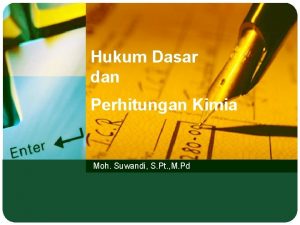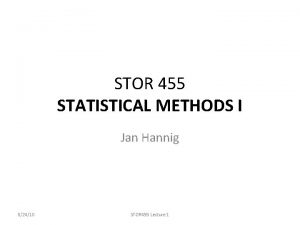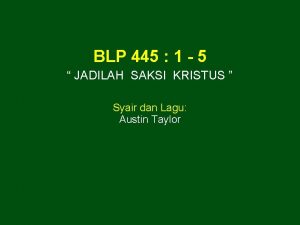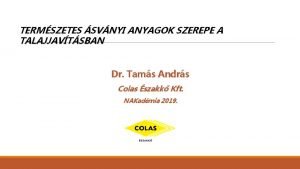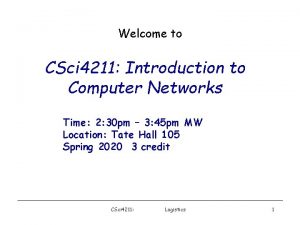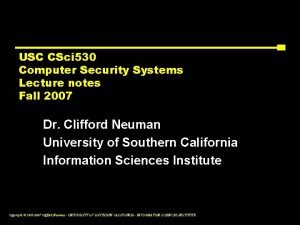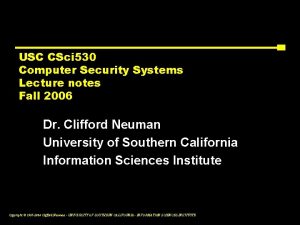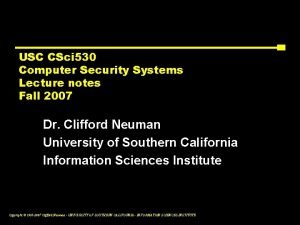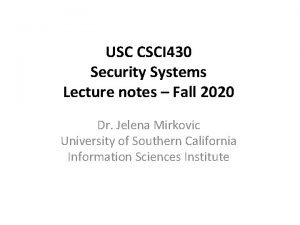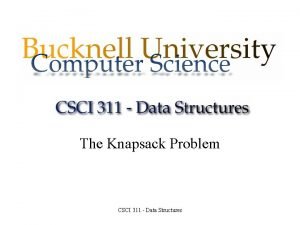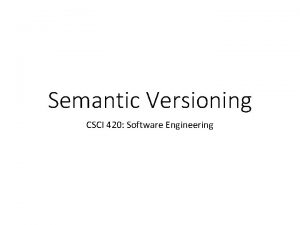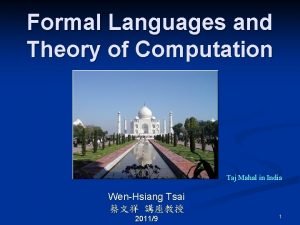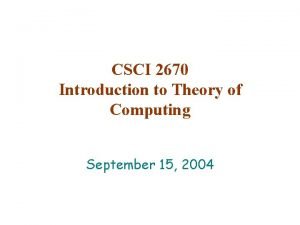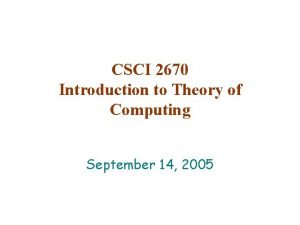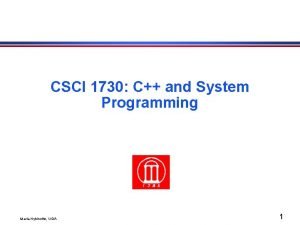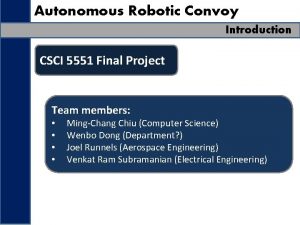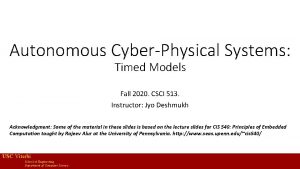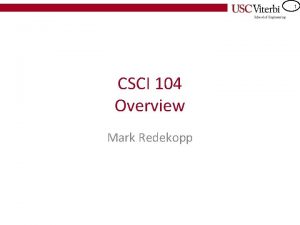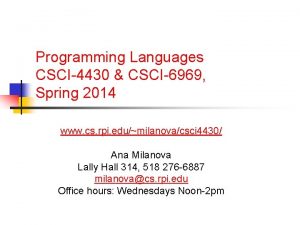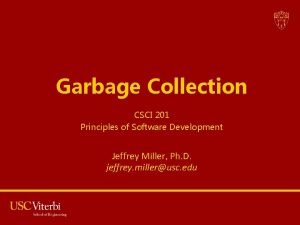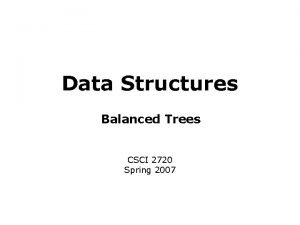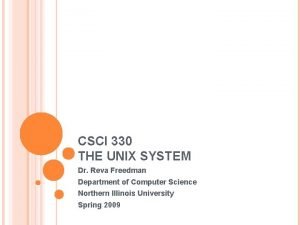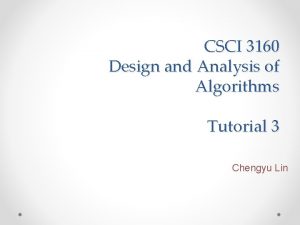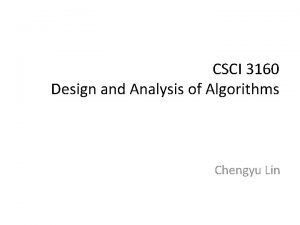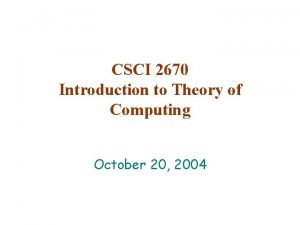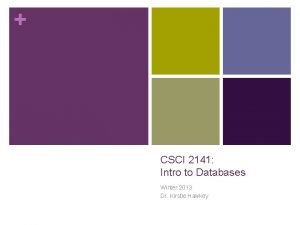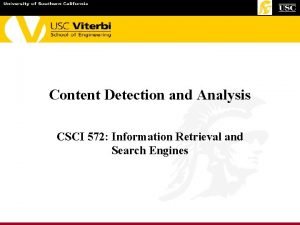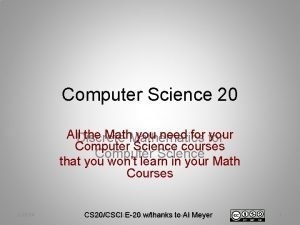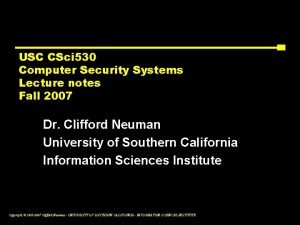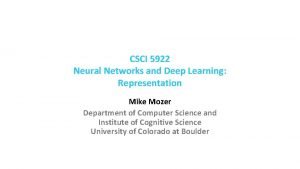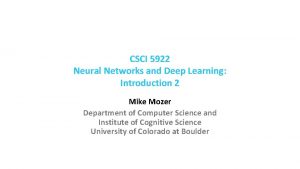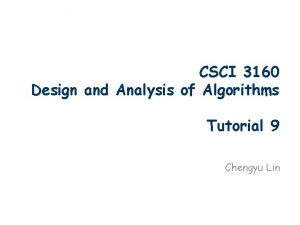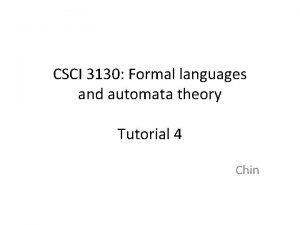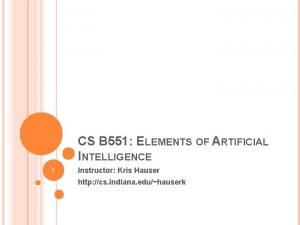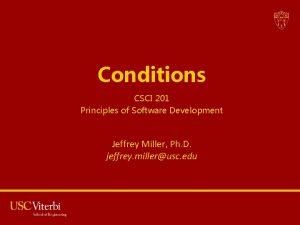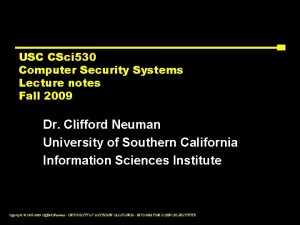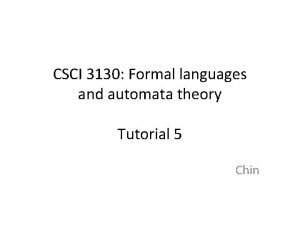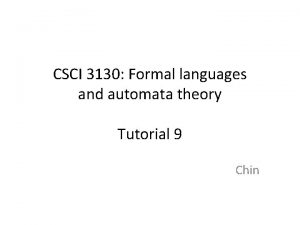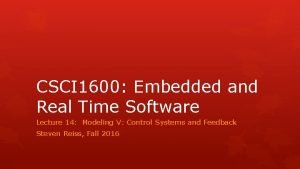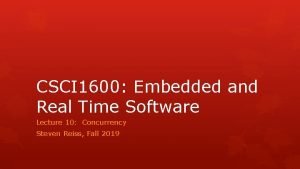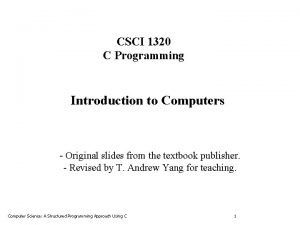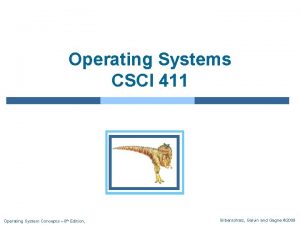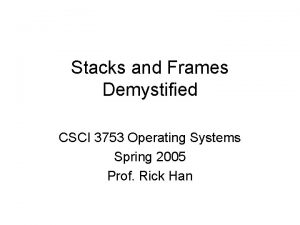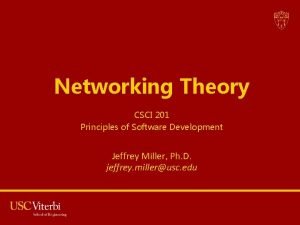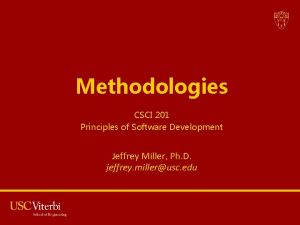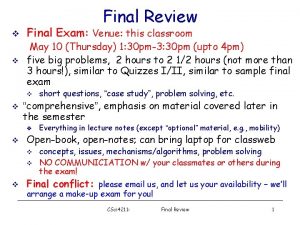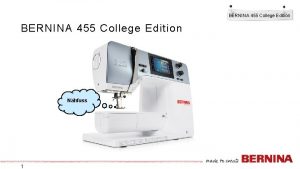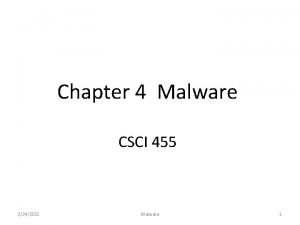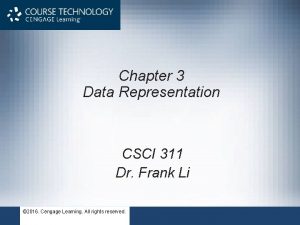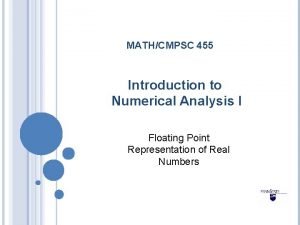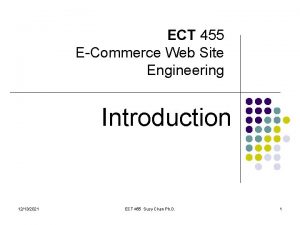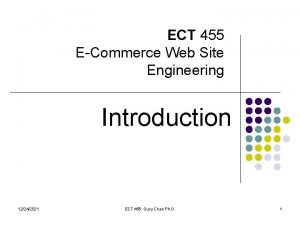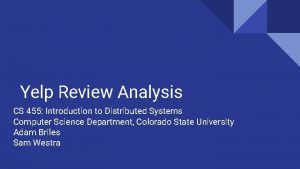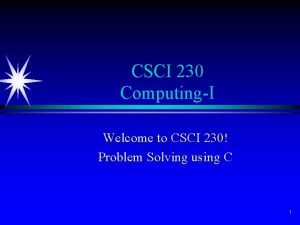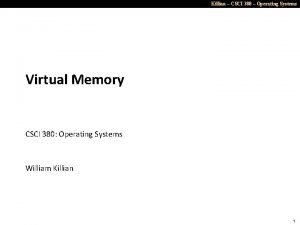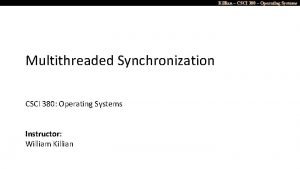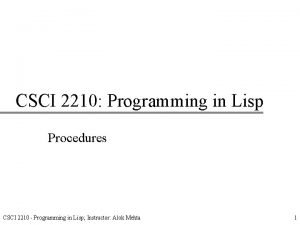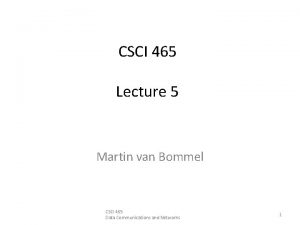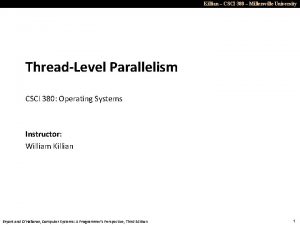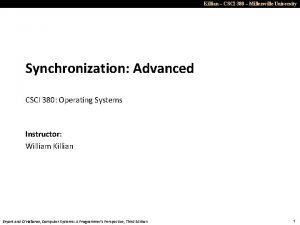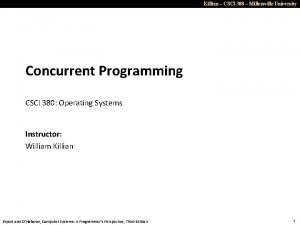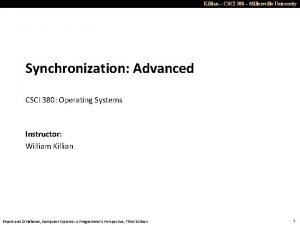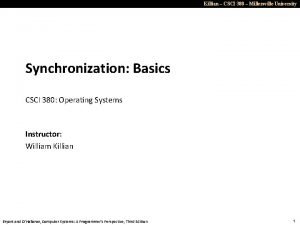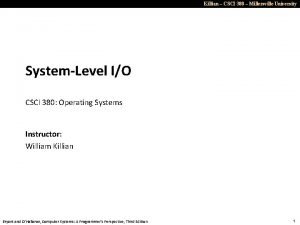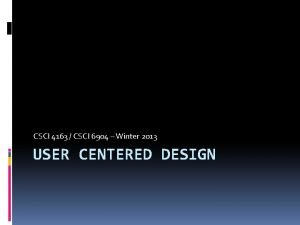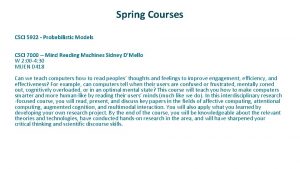Chapter 1 Introduction CSCI 455 Dr Frank Li




























































- Slides: 60

Chapter 1 – Introduction CSCI 455 Dr. Frank Li 1

Section 1. 1 – Fundamental Concepts • The security of a system, application, or protocol is always relative to – A set of desired properties – An adversary with specific capabilities • For example, standard file access permissions in Linux and Windows are not effective against an adversary who can boot from a CD Why? 2

Security Goals Integrity • C. I. A. Confidentiality Availability 3

Confidentiality • Confidentiality is the avoidance of the unauthorized disclosure of information. – confidentiality involves the protection of data, providing access for those who are allowed to see it while disallowing others from learning anything about its content. • Tools for Confidentiality: – – – Encryption Access control Authentication Authorization Physical security 4

Tools for Confidentiality • Encryption: the transformation of information using a secret, called an encryption key, so that the transformed information can only be read using another secret, called the decryption key (which may, in some cases, be the same as the encryption key). Communication channel Sender encrypt Recipient decrypt ciphertext plaintext shared secret key Attacker (eavesdropping) 5

Tools for Confidentiality • Access control: rules and policies that limit access to confidential information to those people and/or systems with a “need to know. ” – This need to know may be determined by identity, such as a person’s name or a computer’s serial number, – or by a role that a person has, such as being a manager or a computer security specialist. 6

Tools for Confidentiality • Authentication: the determination of the identity or role that someone has. This determination can be done in a number of different ways, but it is usually based on a combination of – something the person has (like a smart card or a radio key fob storing secret keys), – something the person knows (like a password), – something the person is (like a human with a fingerprint). password=uc. Ib()w 1 V mother=Jones pet=Caesar human with fingers and eyes Something you are Something you know radio token with secret keys Something you have 7

Tools for Confidentiality • Authorization: the determination if a person or system is allowed access to resources, based on an access control policy. – Such authorizations should prevent an attacker from tricking the system into letting him have access to protected resources. • Physical security: the establishment of physical barriers to limit access to protected computational resources. – Such barriers include locks on cabinets and doors, the placement of computers in windowless rooms, – the use of sound dampening materials, – and even the construction of buildings or rooms with walls incorporating copper meshes (called Faraday cages) so that electromagnetic signals cannot enter or exit the enclosure. 8

Integrity • Integrity: the property that information has not be altered in an unauthorized way. • Tools: – Backups: the periodic archiving of data. – Checksums: the computation of a function that maps the contents of a file to a numerical value. • A checksum function depends on the entire contents of a file and is designed in a way that even a small change to the input file (such as flipping a single bit) is highly likely to result in a different output value. – Data correcting codes: methods for storing data in such a way that small changes can be easily detected and automatically corrected. 9

Availability • Availability: the property that information is accessible and modifiable in a timely fashion by those authorized to do so. • Tools: – Physical protections: infrastructure meant to keep information available even in the event of physical challenges. – Computational redundancies: computers and storage devices that serve as fallbacks in the case of failures. 10

Other Security Concepts Authenticity • A. A. A. Anonymity Assurance 11

Assurance (self-study) • Assurance refers to how trust is provided and managed in computer systems. • Trust management depends on: – Policies, which specify behavioral expectations that people or systems have for themselves and others. • For example, the designers of an online music system may specify policies that describe how users can access and copy songs. – Permissions, which describe the behaviors that are allowed by the agents that interact with a person or system. • For instance, an online music store may provide permissions for limited access and copying to people who have purchased certain songs. – Protections, which describe mechanisms put in place to enforce permissions and polices. • We could imagine that an online music store would build in protections to prevent people from unauthorized access and copying of its songs. 12

Authenticity • Authenticity is the ability to determine that statements, policies, and permissions issued by persons or systems are genuine. • Primary tool: – digital signatures. These are cryptographic computations that allow a person or system to commit to the authenticity of their documents in a unique way that achieves nonrepudiation, which is the property that authentic statements issued by some person or system cannot be denied. 13

Anonymity (self-study) • Anonymity: the property that certain records or transactions not to be attributable to any individual. • Tools: – Aggregation: the combining of data from many individuals so that disclosed sums or averages cannot be tied to any individual. – Mixing: the intertwining of transactions, information, or communications in a way that cannot be traced to any individual. – Proxies: trusted agents that are willing to engage in actions for an individual in a way that cannot be traced back to that person. – Pseudonyms: fictional identities that can fill in for real identities in communications and transactions, but are otherwise known only to a trusted entity. 14

Threats and Attacks (1) • Eavesdropping: the interception of information intended for someone else during its transmission over a communication channel. Alice Bob Eve 15

Threats and Attacks (2) • Alteration: unauthorized modification of information. – Example: the man-in-the-middle attack, where a network stream is intercepted, modified, and retransmitted. Communication channel Sender encrypt Recipient decrypt plaintext M′ shared secret key ciphertext C′ Attacker (intercepting) shared secret key 16

Threats and Attacks (3) • Denial-of-service: the interruption or degradation of a data service or information access. – Example: email spam, to the degree that it is meant to simply fill up a mail queue and slow down an email server. Alice 17

Threats and Attacks (4) • Masquerading: the fabrication of information that is purported to be from someone who is not actually the author. “From: Alice” (really is from Eve) 18

Threats and Attacks (5) • Repudiation: the denial of a commitment or data receipt. – This involves an attempt to back out of a contract or a protocol that requires the different parties to provide receipts acknowledging that data has been received. 19 Public domain image from http: //commons. wikimedia. org/wiki/File: Plastic_eraser. jpeg

Threats and Attacks (6) • Correlation and traceback: the integration of multiple data sources and information flows to determine the source of a particular data stream or piece of information. Bob 20

The Ten Security Principles (self-study) Compromis e recording Work factor Psychologic al acceptabilit y Economy of mechanism Fail-safe defaults Security Principles Least common mechanism Least privilege Complete mediation Open design Separation of privilege 21

Economy of mechanism • This principle stresses simplicity in the design and implementation of security measures. – While applicable to most engineering endeavors, the notion of simplicity is especially important in the security domain, since a simple security framework facilitates its understanding by developers and users and enables the efficient development and verification of enforcement methods for it. 22

Fail-safe defaults • This principle states that the default configuration of a system should have a conservative protection scheme. – For example, when adding a new user to an operating system, the default group of the user should have minimal access rights to files and services. Unfortunately, operating systems and applications often have default options that favor usability over security. – This has been historically the case for a number of popular applications, such as web browsers that allow the execution of code downloaded from the web server. 23

Complete mediation • The idea behind this principle is that every access to a resource must be checked for compliance with a protection scheme. – As a consequence, one should be wary of performance improvement techniques that save the results of previous authorization checks, since permissions can change over time. – For example, an online banking web site should require users to sign on again after a certain amount of time, say, 15 minutes, has elapsed. 24

Open design • According to this principle, the security architecture and design of a system should be made publicly available. – Security should rely on keeping cryptographic keys secret. – Open design allows for a system to be scrutinized by multiple parties, which leads to the early discovery and correction of security vulnerabilities caused by design errors. – The open design principle is the opposite of the approach known as security by obscurity, which tries to achieve security by keeping cryptographic algorithms secret and which has been historically used without success by several organizations. 25

Separation of privilege • This principle dictates that multiple conditions should be required to achieve access to restricted resources or have a program perform some action. 26

Least privilege • Each program and user of a computer system should operate with the bare minimum privileges necessary to function properly. – If this principle is enforced, abuse of privileges is restricted, and the damage caused by the compromise of a particular application or user account is minimized. – The military concept of need-to-know information is an example of this principle. 27

Least common mechanism • In systems with multiple users, mechanisms allowing resources to be shared by more than one user should be minimized. – For example, if a file or application needs to be accessed by more than one user, then these users should have separate channels by which to access these resources, to prevent unforeseen consequences that could cause security problems. 28

Psychological acceptability • This principle states that user interfaces should be well designed and intuitive, and all security-related settings should adhere to what an ordinary user might expect. 29

Work factor • According to this principle, the cost of circumventing a security mechanism should be compared with the resources of an attacker when designing a security scheme. – A system developed to protect student grades in a university database, which may be attacked by snoopers or students trying to change their grades, probably needs less sophisticated security measures than a system built to protect military secrets, which may be attacked by government intelligence organizations. 30

Compromise recording • This principle states that sometimes it is more desirable to record the details of an intrusion than to adopt more sophisticated measures to prevent it. – Internet-connected surveillance cameras are a typical example of an effective compromise record system that can be deployed to protect a building in lieu of reinforcing doors and windows. – The servers in an office network may maintain logs for all accesses to files, all emails sent and received, and all web browsing sessions. 31

Section 1. 2 - Access Control Models Some security questions can be answered by access control models • • • 9/16/2020 Which users can read/write which files? Are my files really safe? What does it mean to be root? What do we really want to control? Etc. Introduction 32

Access Control Matrices • A table that defines permissions. – Each row of this table is associated with a subject, which is a user, group, or system that can perform actions. – Each column of the table is associated with an object, which is a file, directory, document, device, resource, or any other entity for which we want to define access rights. – Each cell of the table is then filled with the access rights for the associated combination of subject and object. – Access rights can include actions such as reading, writing, copying, executing, deleting, and annotating. – An empty cell means that no access rights are granted. 33

Example Access Control Matrix Advantages vs. Disadvantages (self-study) 34

Access Control Lists • It defines, for each object, o, a list, L, called o’s access control list, – which enumerates all the subjects that have access rights for o and, for each subject, s, gives the access rights that s has for object o. – Advantages vs. Disadvantages (self-study) /etc/passwd /usr/bin/ /u/roberto/ /admin/ root: r, w mike: r roberto: r backup: r root: r, w, x mike: r, x roberto: r, x backup: r, x root: r, w, x roberto: r, w, x backup: r, x root: r, w, x backup: r, x 35

Capabilities • Takes a subject-centered approach to access control. – It defines, for each subject s, the list of the objects for which s has nonempty access control rights, together with the specific rights for each such object. • Advantages vs. Disadvantages (self-study) root /etc/passwd: r, w, x; /usr/bin: r, w, x; /u/roberto: r, w, x; /admin/: r, w, x mike /usr/passwd: r; /usr/bin: r, x roberto /usr/passwd: r; /usr/bin: r; /u/roberto: r, w, x backup /etc/passwd: r, x; /usr/bin: r, x; /u/roberto: r, x; /admin/: r, x 36

Role-based Access Control • Define roles and then specify access control rights for these roles, rather than for subjects directly. – Role hierarchies • Advantages vs. Disadvantages (self-study) Department Chair Administrative Manager Accountant Secretary Administrative Personnel Lab Manager System Administrator Lab Technician Undergraduate TA Backup Agent Technical Personnel Department Member Undergraduate Student Faculty Graduate TA Graduate Student 37

Section 1. 3 - Cryptographic Concepts • Encryption: a means to allow two parties, customarily called Alice and Bob, to establish confidential communication over an insecure channel that is subject to eavesdropping. Alice Bob Eve 38

Encryption and Decryption • The message M is called the plaintext. • Alice will convert plaintext M to an encrypted form using an encryption algorithm E that outputs a ciphertext C for M. Communication channel Sender encrypt Recipient decrypt ciphertext plaintext shared secret key Attacker (eavesdropping) 39

Encryption and Decryption • As equations: C = E(M) M = D(C) – The encryption and decryption algorithms are chosen so that it is infeasible for someone other than Alice and Bob to determine plaintext M from ciphertext C. – Thus, ciphertext C can be transmitted over an insecure channel that can be eavesdropped by an adversary. 40

Cryptosystem 1. 2. 3. 4. 5. The set of possible plaintexts The set of possible ciphertexts The set of encryption keys The set of decryption keys The correspondence between encryption keys and decryption keys 6. The encryption algorithm to use 7. The decryption algorithm to use 41

Caesar Cipher • Replace each letter with the one “three over” in the alphabet. 42 Public domain image from http: //commons. wikimedia. org/wiki/File: Caesar 3. svg

Symmetric Cryptosystems • Alice and Bob share a secret key, which is used for both encryption and decryption. Communication channel Sender encrypt Recipient decrypt ciphertext plaintext shared secret key Attacker (eavesdropping) 43

Symmetric Key Distribution • Requires each pair of communicating parties to share a (separate) secret key. – How many unique keys are needed for N users? shared secret shared secret 44

Public-Key Cryptography • Bob has two keys: a private key, SB, which Bob keeps secret, and a public key, PB, which Bob broadcasts widely. – In order for Alice to send an encrypted message to Bob, she need only obtain his public key, PB, use that to encrypt her message, M, and send the result, C = EPB (M), to Bob then uses his secret key to decrypt the message as M = DSB (C). 45

Public-Key Cryptography • Separate keys are used for encryption and decryption. Communication channel Sender encrypt plaintext Recipient decrypt plaintext ciphertext plaintext public key private key Attacker (eavesdropping) 46

Public Key Distribution • Only one key is needed for each recipient private public n key pairs private 47

Digital Signatures • Public-key encryption provides a method for doing digital signatures • To sign a message, M, Alice just encrypts it with her private key, SA, creating C = ESA(M). • Anyone can decrypt this message using Alice’s public key, as M’ = DPA(C), and compare that to the message M. 48

Cryptographic Hash Functions • A checksum on a message, M, that is: • One-way: it should be easy to compute Y=H(M), but hard to find M given only Y • Collision-resistant: it should be hard to find two messages, M and N, such that H(M)=H(N). • Examples: SHA-1, SHA-256. 49

Message Authentication Codes • Allows for Alice and Bob to have data integrity, if they share a secret key. • Given a message M, Alice computes H(K||M) and sends M and this hash to Bob. Communication channel h message M Sender shared secret key 6 B 34339 4 C 66809 MAC Attacker (modifying) (attack detected) 4 C 66809 87 F 9024 =? received MAC h computed MAC message M’ shared secret key Recipient 50

Digital Certificates • certificate authority (CA) digitally signs a binding between an identity and the public key for that identity. 51

Passwords • A short sequence of characters used as a means to authenticate someone via a secret that they know. • Userid: _________ • Password: _______ 52

Section 1. 4 – Implementation and Usability Issues • Efficiency and Usability – Example … • Passwords • Social engineering 53

How a password is stored? User Password file Dog 124 hash function Butch: ASDSA 21 QW 3 R 50 E ERWWER 323 … …

Strong Passwords • What is a strong password – UPPER/lower case characters – Special characters – Numbers • When is a password strong? – Seattle 1 – M 1 ke 03 – P@$$w 0 rd – TD 2 k 5 sec. V 55

Password Complexity • A fixed 6 symbols password: – Numbers 106 = 1, 000 – UPPER or lower case characters 266 = 308, 915, 776 – UPPER and lower case characters 526 = 19, 770, 609, 664 – 32 special characters (&, %, $, £, “, |, ^, §, etc. ) 326 = 1, 073, 741, 824 • 94 practical symbols available – 946 = 689, 869, 781, 056 • ASCII standard 7 bit 27 =128 symbols – 1286 = 4, 398, 046, 511, 104 56

Password Length • • 26 UPPER/lower case characters = 52 characters 10 numbers 32 special characters => 94 characters available • • • 5 characters: 945 = 6 characters: 946 = 7 characters: 947 = 8 characters: 948 = 9 characters: 949 = 7, 339, 040, 224 689, 869, 781, 056 64, 847, 759, 419, 264 6, 095, 689, 385, 410, 816 572, 994, 802, 228, 616, 704 57

Password Validity: Brute Force Test • Password does not change for 60 days • how many passwords should I try for each second? – 5 characters: 1, 415 PW /sec – 6 characters: 133, 076 PW /sec – 7 characters: 12, 509, 214 PW /sec – 8 characters: 1, 175, 866, 008 PW /sec – 9 characters: 110, 531, 404, 750 PW /sec 58

Secure Passwords • A strong password includes characters from at least three of the following groups: • Use pass phrases eg. "I re@lly want to buy 11 Dogs!" 59

Social Engineering • Pretexting: creating a story that convinces an administrator or operator into revealing secret information. • Baiting: offering a kind of “gift” to get a user or agent to perform an insecure action. • Quid pro quo: offering an action or service and then expecting something in return. 60
 Working at height toolbox talk
Working at height toolbox talk Tis 455
Tis 455 Postmodern british writers
Postmodern british writers Sebanyak 0 455 gram sampel magnesium
Sebanyak 0 455 gram sampel magnesium Stor 455
Stor 455 Rd 455/2010
Rd 455/2010 200 en yakın yüzlüğe yuvarlama
200 en yakın yüzlüğe yuvarlama Jadilah saksi kristus
Jadilah saksi kristus Bodrogkeresztúri riolittufa
Bodrogkeresztúri riolittufa Apelacin
Apelacin $455 in rands
$455 in rands Beautiful tis
Beautiful tis Frank william abagnale jr. young
Frank william abagnale jr. young Csci 4211
Csci 4211 Csci 530
Csci 530 Csci 530 security systems
Csci 530 security systems Netcheque
Netcheque Csci 430
Csci 430 Contoh knapsack problem
Contoh knapsack problem Csci 420
Csci 420 Scott warfield ucf
Scott warfield ucf Csci 1951a
Csci 1951a Csci 2670
Csci 2670 Csci 2670
Csci 2670 Csci 1730 uga
Csci 1730 uga Csci 5551
Csci 5551 Csci 513 usc
Csci 513 usc Csci 104
Csci 104 Fun2data
Fun2data 201 principles of software development
201 principles of software development Csci 2720
Csci 2720 Reva freedman
Reva freedman Csci 3160
Csci 3160 Csci 3160
Csci 3160 Csci 2670
Csci 2670 Csci 2141
Csci 2141 Csci572
Csci572 Csci e-20
Csci e-20 Csci 530 usc
Csci 530 usc Csci 5922
Csci 5922 Csci 5922
Csci 5922 Csci 3160
Csci 3160 Automata theory tutorial
Automata theory tutorial Csci3130
Csci3130 Csci 3130
Csci 3130 Cyk algorithm
Cyk algorithm Csci-b 551 elements of artificial intelligence
Csci-b 551 elements of artificial intelligence Usc csci 201
Usc csci 201 Csci 530 usc
Csci 530 usc Automata theory
Automata theory Csci 3130
Csci 3130 Csci 1600
Csci 1600 Csci 1600
Csci 1600 Csci 1320
Csci 1320 Csci 6620
Csci 6620 Csci 411
Csci 411 Csci 3753
Csci 3753 Csci 201
Csci 201 Csci 201
Csci 201 Csci 4211
Csci 4211 Csci 1933 umn
Csci 1933 umn



